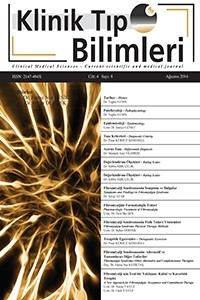Diabetes Mellitus’ta Tıbbi Beslenme Tedavisi İlkeleri
ÖzDiabetes mellitus (DM)’ ta Tıbbi Beslenme Tedavisi (TBT) başarılı bir diyabet tedavisinin en önemli bileşenlerinden biridir. Tıbbi beslenme tedavisinin amacı, kan glikoz seviyesinin ve lipid profilinin kontrolünü sağlayarak metabolik dengeyi kurmak, gerekli besin öğelerinin alınmasını sağlamak, akut ve kronik komplikasyon riskini azaltmaktır. Tedavinin amaçları doğrultusunda hastanın metabolik parametreleri ve yaşamtarzı değerlendirilir, hasta için uygun hedefler saptanır, bu hedefler için öneriler ve eğitimler verilir ve klinik sonuçlar değerlendirilir. Etkin bir TBT hastalarda ağırlık kaybı ile kan glikoz seviyesi, kan basıncı ve kan yağlarında iyileşme sağlar, A1c’yi düşürürve buna bağlı olarak DM ile ilgili komplikasyonları azaltır.
Anahtar Kelimeler:
Diabetes mellitus, tıbbi beslenme tedavisi, diyetisyen
Medical Nutrition Treatment Principles in Diabetes Mellitus
AbstractA medical nutrition therapy is one of the key factors reducing the complicationscaused by Diabetes Mellitus (DM). The aim of medical nutrition therapy is based onproviding metabolic balance as keeping the blood levels of lipids and glucose underthe control, taking daily nutritional elements and reducing the risks of acute and chronic complications. In accordance with the aims of the treatment, the metabolic parameters, dietary history and life style of the patients are evaluated. After the determination of treatment goals, patients are kept informed about their nutritional habits. Asupportive medical nutrition therapy provides healthy loss of weight as lowering anyexisting high levels of cholesterol and glucose and reducing the blood pressure. It alsohelps to lower the amount of Hb1c. Therefore, the complications developing from DM start to get minimized.
Keywords:
Diabetes mellitus, medicalnutrition therapy, dietician,
___
- Kaynaklar 1.American Diabetes Association (2014). Standards Of Medical Careİn Diabetes. Diabetes Care, 37(1), 14-80. 2.Satman I, Omer B, Tutuncu Y et al. Twelve-year trends in the pre-valence and risk factors of diabetes and prediabetes in Turkish adults.Eur J Epidemiol 2013; 28 (2), 169-80. 3.Wild S, Roglic G, Green A, Sicree R, King H. Global Prevalence OfDiabetes: Estimates For The Year 2000 And Projections For 2030.Diabetes Care 2004; 27(5), 1047-53. 4.American Diabetes Association (2016). Standards Of Medical Careİn Diabetes. Diabetes Care, 39(1), 36- 94. 5.Özer E, Yıldız E, Mercanlıgil M, Mercanlıgil S, Uysal C ve ark. Di-yabetin Önlenmesi Ve Tedavisinde Tıbbi Beslenme Tedavisi Rehbe-ri. Eds Mercanlıgil S, Dağ A. Hastalıklarda Diyet Tedavisi. 1. Bas-kı, İstanbul: Türkiye Diyetisyenler Derneği Yayını,2013; 90-120. 6.Saaddine JB, Cadwell B, Gregg EW, Engelgau MM, Vinicor F et al.Improvements in diabetes processes of care and intermediate outcomes:United States, 1988-2002. Ann Intern Med 2006; 144(7), 465-74. 7.Skyler JS. Effects of glycemic control on diabetes complications andon the prevention of diabetes. Clinical Diabetes 2004; 22(4), 162-66. 8.Bozkurt N, Yıldız E. Diabetes Mellistus ve Beslenme Tedavisi. EdsBaysal A, Aksoy M, Besler HT, Bozkurt N, Keçecioğlu S ve ark. Di-yet El Kitabı. 6. Baskı, Ankara: Hatipoğlu Yayınları, 2011; 257-297. 9.Alphan ET. Diabetes Mellistus ve Beslenme Tedavisi. Eds Alphan ET.Hastalıklarda Beslenme Tedavisi. 1. Baskı, Ankara: Hatipoğlu Ya-yınları, 2013; 415-509. 10.Türkiye Diyabet Vakfı. Diyabet tanı ve tedavi rehberi 2015. Güncel-lenmiş 5. baskı, İstanbul, Eos Yayıncılık, 2015; 45-58. 11.Vaughan L: Dietary guidelines for the management of diabetes. Nur-sing Standard 2005; 19, 56-64. 12.Özer E Ve Ark. Algoritmalarla Diyabette Tıbbi Beslenme TedavisiRehberi-2011, Diyabet Forumu 2011; 7 (2), 32. 13.American Diabetes Association. (2015). 12. Management of Diabe-tes in Pregnancy. Diabetes Care 2015; 38 (1), 77-79. 14.Özer E. Kan Şekeri Kontrolü İçin Karbonhidrat Sayımı. Türkiye Di-yabet Vakfı, İstanbul 2003.
- ISSN: 2147-494X
- Başlangıç: 2013
- Yayıncı: Selen Medya Yayıncılık Tanıtım ve Organizasyon Hizmetleri
Sayıdaki Diğer Makaleler
Çocuk ve Adolesanlarda Tip-2 Diyabetin Tanısı ve Yönetimi
Metabolik Cerrahi Sonrası DiyabetliHastanın Beslenmesi
Yrd. Doç. Dr. Dyt. Nihal Zekiye ERDEM
Tip 2 Diyabette Güncel FarmakolojikTedavi Algoritması
Tip 1 Diyabetli Bir Hastanın Tedavi veİzlemindeki Püf Noktaları
Pankreas Adacık Transplantasyonu Çalışmalarındaki Son Durum
Doç. Dr. Süleyman Hilmi İPEKÇİ
Diyabetli Hastalarda Egzersiz Reçetesi
Yapay Pankreas: Bugünü ve Yarını
Pregestasyonel Diyabeti Olanlarda Rehberlik, Tedavi ve İzlem
Gastrointestinal Sistem Otonom Nöropatinin Tanı ve Tedavisi
İnsülin Direnci İçin Pratik Değerlendirme Yöntemleri ve Yaklaşım
